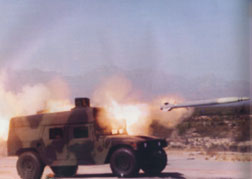 LOSAT is a dedicated antitank weapon system providing a high rate of extremely lethal fire at ranges exceeding tank main gun range, making it capable of defeating
any known or projected armor system. LOSAT is a precision engagement system that enhances the Army's ability to dominate the ground maneuver battle. The key attraction of LOSAT is the tremendous overmatch lethality of the KEM that defeats all future predicted armored combat vehicles.
LOSAT is a dedicated antitank weapon system providing a high rate of extremely lethal fire at ranges exceeding tank main gun range, making it capable of defeating
any known or projected armor system. LOSAT is a precision engagement system that enhances the Army's ability to dominate the ground maneuver battle. The key attraction of LOSAT is the tremendous overmatch lethality of the KEM that defeats all future predicted armored combat vehicles.
The system utilizes a Heavy High Mobility Multipurpose Wheeled Vehicle (HMMWV) heavy chassis, hypervelocity kinetic energy missiles (KEM), a second generation forward-looking infrared (FLIR/TV) acquisition sensor and has a crew of two. The LOSAT system consists of a Humvee armed with four ready-to-fire missiles, with eight missiles towed behind in a resupply trailer. The LOSAT System carries four ready missiles via two two-pack containers. LOSAT can operate autonomously or with other systems using its digitized Command and Control capability.
The missile accelerates to 5000 feet per second, flies to maximum range in less than four seconds and delivers five times the kinetic energy of current tank rounds. Range of the LOSAT missile is about 5 km. The fire control system allows the gunner/commander to acquire and auto-track up to three targets. Once a launch consent is issued, the system automatically initializes and guides the missiles to the targets in a sequential manner. It is deployable on C-130 through C-5 aircraft including airdrop from the C-130. LOSAT has the requirement to be both airdropped from a C-130 or slingloaded under a UH-60L.Initially, LOSAT was to be mounted on an extended length Bradley Fighting Vehicle. As a Technology Demonstration it was to be mounted on an Armored Gun System (AGS) chassis but when the AGS program was canceled, LOSAT was reconfigured to a HMMWV chassis. Developmental testing has been conducted using the fire control system to direct the kinetic energy missile at tank targets.
Testing at White Sands Missile Range, NM examined the launch effects of the LOSAT on an expanded-capacity HMMWV. Under developmental test conditions, the missile is capable of defeating any known tank it hits. Test firing of the LOSAT missile in a non-tactical configuration on top of a HMMWV has shown all launch effects to fall within the Army's acceptable ranges for human factor limits. Data gathered were extensive both inside and outside of the vehicle. Measurements were made of shock and g-load, on crash test dummies, and flash, toxic gases, pressure, and sound in and outside the vehicle. Numerous operational performance issues must be addressed in future testing � either within the ACTD or in subsequent formal OT&E covered by a TEMP. The LOSAT program has been around since 1989, and was started an Army ACAT I system with oversight by DOT&E. In 1992, analysis by the Army caused the program to be reduced to a Technology Demonstration. In May 1994 the House Armed Services Committee directed the Army to make an early decision on whether it should continue or rapidly terminate the LOSAT program. The committee believed that since there was no foreseeable plan for LOSAT, cost savings could be achieved in fiscal year 1996 by early termination of the program. LOSAT was canceled by the Defense Department as a budget decision in November 1996. The Army appealed, and the proposed weapon continued as a technology demonstration effort. LOSAT received final approval as an FY'98 Advanced Concept Technology Demonstration (ACTD) new start the week of 17 November 97. The ACTD will assess survivability of the HMMWV based system and develop a concept of operations (CONOPS) for survivability through deception. The ACTD will also demonstrate enhanced deployability/mobility with the ability to fire upon landing. In April 1998 Lockheed Martin Corp., Lockheed Martin Vought Systems, Grand Prairie, Texas, was awarded a $5,000,000 increment as part of a $214,239,685 (total if all options are exercised, base year plus four option years) cost-plus-incentive-fee contract for the LOSAT Advanced Concept Technology Demonstration (ACTD) Program, a 72 month research and development effort. This includes five years of development plus two years for extended user evaluation. The LOSAT ACTD will stretch over the 4-5 years; however any additional funding can shorten that timeline.Although the Joint Requirements Oversight Council upgraded the program to an Advanced Concept Technology Demonstration (ACTD) in 4QFY97, formal testing of the LOSAT has remained severely limited. As a result of the ACTD, a LOSAT Company will activate in XVIII Corps, which will conduct testing with the Infantry School. After testing, these soldiers are to receive 12-13 fire units and 144-178 tactical missiles by April 2003. This hardware will remain with the soldiers for the two-year extended user evaluation after the demonstration. Testing is expected to resume in 2002. Three demonstrations are scheduled: tactical deployability at Fort Bragg in June 2002; lethality live-fire at White Sands Missile Range, N.M., in September 2002; and a force-on-force operational assessment at the National Training Center, Fort Irwin, Calif., in June 2003.


